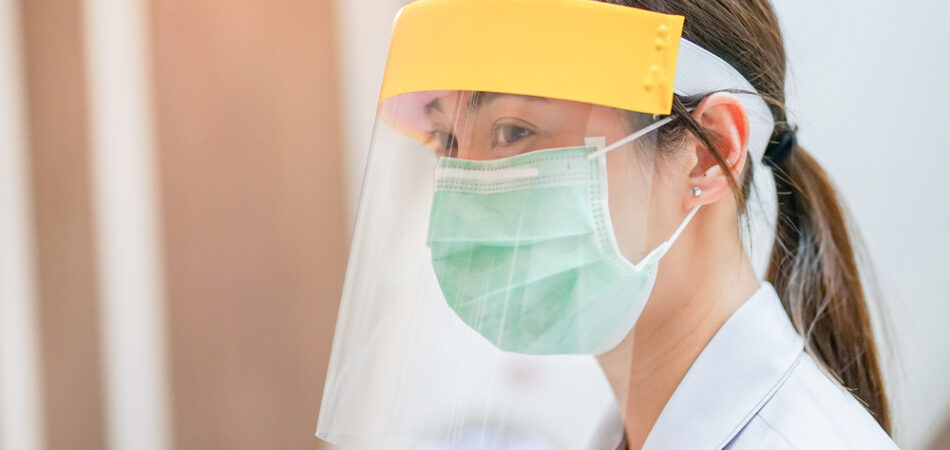
Manufactured in China and regulated by the Chinese National Medical Products Administration (NMPA), KN95 masks are not approved by the U.S. National Institutes of Occupational Safety and Health (NIOSH) but remain available for purchase as protection against COVID-19 and other airborne contaminants. In 2020, when the pandemic increased shortages of all NIOSH-approved masks, the FDA issued an emergency approval that allowed healthcare professionals to wear KN95 masks.
KN95 vs N95 Masks
KN95 masks offer protective features that are similar to NIOSH-approved N95 masks. For example, both masks rate at least a 95 percent filtering efficiency for particulates as small as 0.1 microns. Both contain layers of special material within the mask part that capture bacteria, viruses, and other airborne pathogens before they can be inhaled. However, KN95 masks are slightly inferior to N95 masks due to using ear loops to attach the mask to a person’s face. N95 masks have two elastic straps, not ear loops, which help create a nearly impermeable seal between the face and mask. Consequently, KN95s leave small gaps at the sides of the mask that may allow infiltration of pathogens like coronavirus.
How Many Times Can You Reuse a KN95 Mask?
The CDC recommends reusing K95 masks for no more than 40 hours or a maximum of four or five times. For example, you could wear the same KN95 mask five hours per day for eight days. However, the CDC advises you alternate between two KN95 masks by allowing one mask to air out for 24 to 48 hours while wearing the other KN95.
Reusing KN95 masks also depends on the conditions in which the mask is being worn. Healthcare professionals and people working in high-particulate environments should wear a new KN95 mask each day. If you are wearing a KN95 in an office setting involving less than ten people, it is safe to reuse KN95 masks several times before they lose their filtration efficiency.
What is the Saturation Limit of KN95 Masks?
KN95s and N95s can handle approximately 200 milligrams (two grams) of pathogens and particulates. When one of these masks is saturated with this many particles, it’s likely the mask has broken straps, is visibly soiled, or is experiencing other types of deterioration and should be thrown away.
Can You Reuse a KN95 After Exposure to Someone Infected with COVID-19?
Viruses can live on the surface of KN95 masks for several hours. If you have worn a KN95 around a person you know or later find out was infected with the coronavirus, you could inadvertently touch the mask and transfer the virus to your facial mucous membranes, such as the mouth or eyes. Carefully remove the mask by touching the straps only and either discard it or place it somewhere away from other people to air out for one or two days.
What If a KN95 Mask is Accidently Washed with Laundry? Can You Let It Dry Out and Reuse It?
Anytime a KN95 becomes soaked with moisture, consider it permanently damaged and throw it away. Never let a KN95 mask dry out after it is washed or worn outside in the rain. The materials lining the interior of the mask will be unable to capture and hold pathogens or particulates due to moisture damage.
How Long Can You Wear KN95 Masks in Industrial Settings?
KN95 masks may be worn in settings other than healthcare facilities, like machine shops and chemical processing plants. However, they must comply with NIOSH performance recommendations to avoid noncompliance penalties issued by OSHA. The quantitative leakage performance and filtration efficiency are especially important to NIOSH guidelines regarding KN95 masks for use in industrial facilities.
Testing of KN95 masks must be conducted by an ISO-17025 accredited laboratory equipped with devices necessary for ensuring quantitative leakage and filtration efficiency meets ASTM standards. However, KN95 and N95 masks cannot protect against toxic gases or fumes because they do not contain charcoal or other solid elements that will absorb and retain gaseous molecules.
Is There a Way to Extend the Usability of a KN95 Mask?
The best way to get the most out of KN95 masks is to remove them carefully after each use and allow them to air out in a safe place. Placing them in a paper lunch bag for several days is one option when airing a mask. Hanging KN95 masks individually on an indoor clothesline is another option. Never attempt to glue or pin straps to the mask if they become torn away from the mask. This increases the risk of leakage and raises the possibility that the mask could break at an inopportune time.
KN95 Masks vs. Face Shield Visor Medical Protection
Although the COVID-19 pandemic is beginning to wind down and infection rates have plummeted worldwide, healthcare professionals must continue being cautious while working in large medical facilities. While KN95 masks provide excellent protection against coronavirus and other infectious pathogens, supplementing a KN95 mask with a medical-grade face shield offers even better protection. Neither a KN95 nor an N95 mask can prevent bodily fluids from splashing on the face and possibly into the eyes.
There is also the potential for body fluids to spray onto the mask, allowing large, highly infectious droplets to soak the mask material. Face masks are intended to capture microscopic droplets of fluids emitted by talking, coughing, or sneezing. They are incapable of handling larger droplets of body fluids infected with pathogens. A KN95 partly saturated with droplets of infected blood cannot prevent the wearer from inhaling viral or bacterial pathogens.
Tru-Vision Plastics, Inc. is a nation-leading producer of medical face shield visors that can be worn with KN95s, N95s, and other face masks. Call us today to learn how we can make customized face shields to address your company’s needs.
